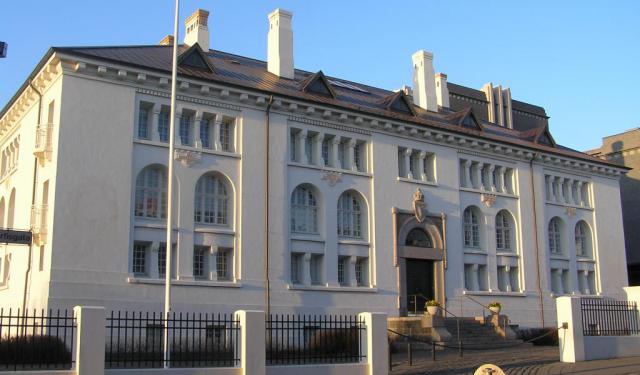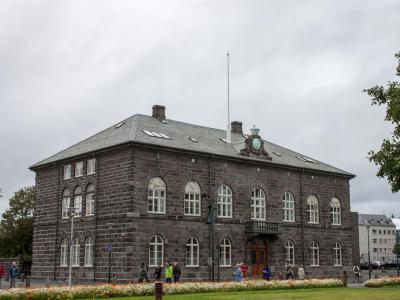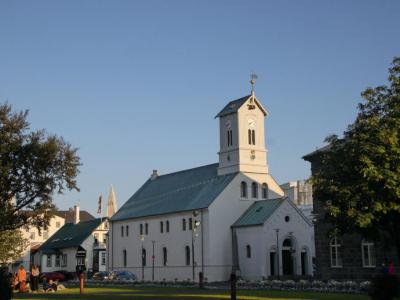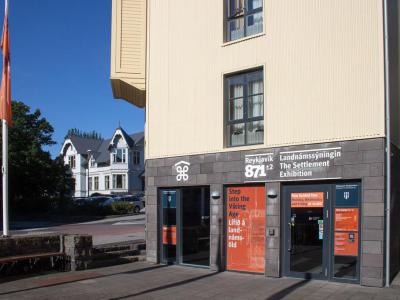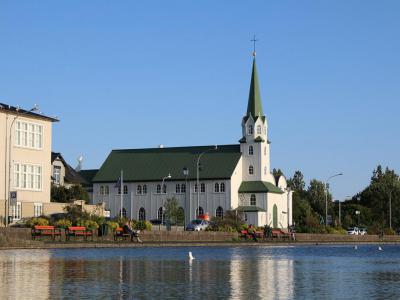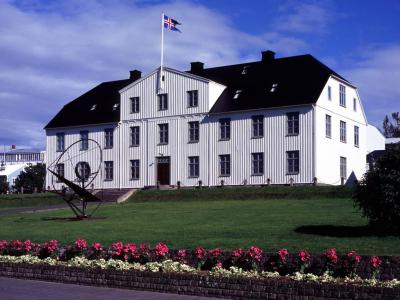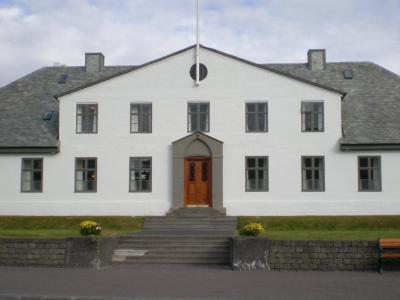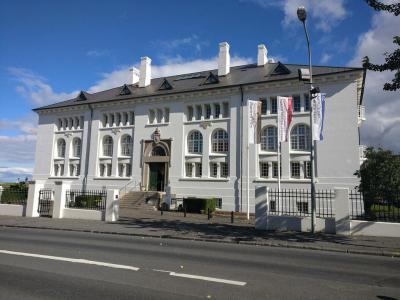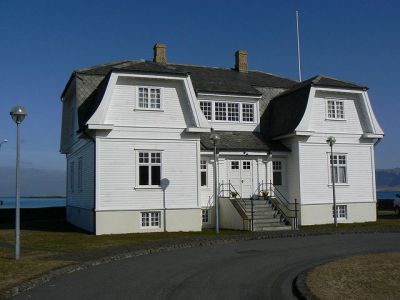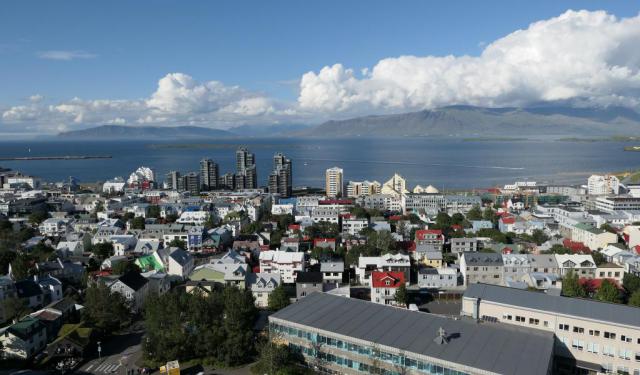Reykjavik Historical Buildings Tour (Self Guided), Reykjavik
Reykjavik, although primarily famous as a base from which to explore the rest of Iceland, is surprisingly full of unique historic locations, many of which are off the beaten path and thus not overrun with tourists. In fact, unless you're accompanied by a historian or knowledgeable local, you can easily walk right past them and not realize their historical importance.
Relatively small in size, the Icelandic capital has no shortage of surprises appealing to people with a wide variety of interests. History buffs will certainly be impressed by the city’s old buildings and relics of its Viking and medieval past.
The places commemorating founders and leaders of various sort, as well as important events in the country, are within a walking distance in the thriving downtown area. Here are some of the historical sights in Reykjavik to be visited while strolling around the city:
Althingishus – the Parliament House built in 1881, one of the oldest stone buildings in Iceland.
The Settlement Exhibition – features the remains of a hall from the Settlement Age (10th century AD), excavated in 2001.
Reykjavik Junior College – the oldest gymnasium in Reykjavík, established 1056.
Stjórnarráðshúsið – home to the Prime Minister's Office, originally built as the first dungeon in Iceland, back in the mid 18th century.
Hofdi – a Reykjavík house best known as the location for the 1986 summit between Ronald Reagan (USA) and Mikhail Gorbachev (USSR).
To broaden your knowledge of Iceland's history and culture, and to discover the historic spots in Reykjavik that you may probably have never heard of, check out this self-guided walking tour and make your stay in the city more enjoyable.
Relatively small in size, the Icelandic capital has no shortage of surprises appealing to people with a wide variety of interests. History buffs will certainly be impressed by the city’s old buildings and relics of its Viking and medieval past.
The places commemorating founders and leaders of various sort, as well as important events in the country, are within a walking distance in the thriving downtown area. Here are some of the historical sights in Reykjavik to be visited while strolling around the city:
Althingishus – the Parliament House built in 1881, one of the oldest stone buildings in Iceland.
The Settlement Exhibition – features the remains of a hall from the Settlement Age (10th century AD), excavated in 2001.
Reykjavik Junior College – the oldest gymnasium in Reykjavík, established 1056.
Stjórnarráðshúsið – home to the Prime Minister's Office, originally built as the first dungeon in Iceland, back in the mid 18th century.
Hofdi – a Reykjavík house best known as the location for the 1986 summit between Ronald Reagan (USA) and Mikhail Gorbachev (USSR).
To broaden your knowledge of Iceland's history and culture, and to discover the historic spots in Reykjavik that you may probably have never heard of, check out this self-guided walking tour and make your stay in the city more enjoyable.
How it works: Download the app "GPSmyCity: Walks in 1K+ Cities" from Apple App Store or Google Play Store to your mobile phone or tablet. The app turns your mobile device into a personal tour guide and its built-in GPS navigation functions guide you from one tour stop to next. The app works offline, so no data plan is needed when traveling abroad.
Reykjavik Historical Buildings Tour Map
Guide Name: Reykjavik Historical Buildings Tour
Guide Location: Iceland » Reykjavik (See other walking tours in Reykjavik)
Guide Type: Self-guided Walking Tour (Sightseeing)
# of Attractions: 8
Tour Duration: 2 Hour(s)
Travel Distance: 2.9 Km or 1.8 Miles
Author: vickyc
Sight(s) Featured in This Guide:
Guide Location: Iceland » Reykjavik (See other walking tours in Reykjavik)
Guide Type: Self-guided Walking Tour (Sightseeing)
# of Attractions: 8
Tour Duration: 2 Hour(s)
Travel Distance: 2.9 Km or 1.8 Miles
Author: vickyc
Sight(s) Featured in This Guide:
- Althingishus (The Parliament House)
- Dómkirkjan (Reykjavík Cathedral)
- The Settlement Exhibition
- Fríkirkjan (Free Church)
- Reykjavik Junior College
- Stjórnarráðshúsið (Prime Minister 's Office)
- Culture House
- Hofdi
1) Althingishus (The Parliament House)
Danish architect Ferdinand Meldahl designed The Parliament House Completed in 1881, The Parliament House is a classical building and was built using hewn dolerite, a subvolcanic rock. It is known as one of the oldest stone buildings in Iceland.
Reliefs on the tympanums represent Iceland's four Land Spirits. The dragon, a vulture, a bull, and a giant represent these traditional Norse spirits. On the north side of the building, visitors will notice King Christian IX's crown and crest.
The Parliament House is home to Althingi, the Icelandic parliament. In the past, it was also used to house the University of Iceland and the offices of the President of Iceland.
Althingi was first held in Iceland in 930, and as such, is one of the oldest parliamentary institutions in the world. Meetings have been held at the Parliament House since 1884. Today, Parliament uses the debating chamber, meeting rooms, and staff offices. Parliamentarian's offices and larger meeting rooms are located in other buildings.
The charming garden behind The Parliament House is the oldest public garden in Iceland.
Reliefs on the tympanums represent Iceland's four Land Spirits. The dragon, a vulture, a bull, and a giant represent these traditional Norse spirits. On the north side of the building, visitors will notice King Christian IX's crown and crest.
The Parliament House is home to Althingi, the Icelandic parliament. In the past, it was also used to house the University of Iceland and the offices of the President of Iceland.
Althingi was first held in Iceland in 930, and as such, is one of the oldest parliamentary institutions in the world. Meetings have been held at the Parliament House since 1884. Today, Parliament uses the debating chamber, meeting rooms, and staff offices. Parliamentarian's offices and larger meeting rooms are located in other buildings.
The charming garden behind The Parliament House is the oldest public garden in Iceland.
2) Dómkirkjan (Reykjavík Cathedral)
Reykjavik Cathedral is a neoclassical church designed by Andreas Kirkerup in the 18th century. The Cathedral is centrally located in Austurvollur, Reykjavik's main public square. Reykjavik Cathedral is the seat of the Bishop of Iceland and the Evangelical Lutheran Church of Iceland. It also serves as the parish church for the city center.
This site has been dedicated to churches since the 13th century. Work on the current church began in 1788, and the Reykjavik Cathedral was dedicated in 1796. It was the first building to be completed with the notion that Reykjavik would become the capital of Iceland.
Since 1845, each parliament session begins with mass at the Cathedral, and then members of parliament go together to the parliament house.
The church and Parliament are intertwined and are a central facet of life in Iceland.
The organ was built in Berlin in 1985 and has 31 voices and three manuals. Sculptor Albert Thorvaldsen designed the baptismal font. Leifur Breiofjoro, an Icelandic artist, designed the processional cross.
Reykjavik Cathedral is smaller and less imposing than the Church of Hallgrimur. However, it boasts a rich cultural history and has significant meaning in the daily lives of Iceland's Lutherans. The Christmas mass is broadcasted from Reykjavik Cathedral, and people all over the country tune in to listen to it. New Presidents are inaugurated at Reykjavík Cathedral.
This site has been dedicated to churches since the 13th century. Work on the current church began in 1788, and the Reykjavik Cathedral was dedicated in 1796. It was the first building to be completed with the notion that Reykjavik would become the capital of Iceland.
Since 1845, each parliament session begins with mass at the Cathedral, and then members of parliament go together to the parliament house.
The church and Parliament are intertwined and are a central facet of life in Iceland.
The organ was built in Berlin in 1985 and has 31 voices and three manuals. Sculptor Albert Thorvaldsen designed the baptismal font. Leifur Breiofjoro, an Icelandic artist, designed the processional cross.
Reykjavik Cathedral is smaller and less imposing than the Church of Hallgrimur. However, it boasts a rich cultural history and has significant meaning in the daily lives of Iceland's Lutherans. The Christmas mass is broadcasted from Reykjavik Cathedral, and people all over the country tune in to listen to it. New Presidents are inaugurated at Reykjavík Cathedral.
3) The Settlement Exhibition (must see)
The Settlement Exhibition Reykjavík 871±2 is a showcase dedicated to the early history of Reykjavík, curated by the Reykjavik City Museum. This exhibition draws its content from the results of archaeological excavations conducted on the remains of one of the earliest houses in Iceland, along with discoveries from other dig sites within the city center.
The main focus of this exhibit revolves around the remnants of a hall from the Settlement Age, unearthed during excavations in 2001. This hall was inhabited from approximately 930 to 1000 AD. Adjacent to the hall, there are two pieces of turf that are remnants of a wall constructed prior to the year 871±2, hence the exhibition's name. This precise dating is made possible by analyzing the fallout of volcanic ash from a significant eruption in the Torfajökull area, which left its mark across the region. Researchers can accurately date this event by studying glacial ice in Greenland. Notably, this hall ranks among the oldest human-made structures discovered in Iceland. The exhibit also showcases artifacts from the Viking Age that were uncovered in central Reykjavík and on the island of Viðey.
The main focus of this exhibit revolves around the remnants of a hall from the Settlement Age, unearthed during excavations in 2001. This hall was inhabited from approximately 930 to 1000 AD. Adjacent to the hall, there are two pieces of turf that are remnants of a wall constructed prior to the year 871±2, hence the exhibition's name. This precise dating is made possible by analyzing the fallout of volcanic ash from a significant eruption in the Torfajökull area, which left its mark across the region. Researchers can accurately date this event by studying glacial ice in Greenland. Notably, this hall ranks among the oldest human-made structures discovered in Iceland. The exhibit also showcases artifacts from the Viking Age that were uncovered in central Reykjavík and on the island of Viðey.
4) Fríkirkjan (Free Church)
The Free Church in Reykjavik (Fríkirkjan í Reykjavík) is a separate Lutheran church from Iceland's main church, the Church of Iceland. It's located right in the heart of Iceland's capital city, next to the Tjörnin lake.
This church started in Reykjavik back in the fall of 1899. Initially, around 600 people joined, and this number quickly increased. The Free Church took inspiration from similar churches in Norway and ones set up by Icelanders who moved to North America. They wanted a church that felt more connected to everyday people. Also, Reykjavik was rapidly growing with new neighborhoods and more residents, but the Reykjavik Cathedral couldn't keep up with the needs of the expanding community, especially as more craftsmen and tradespeople settled in.
Not long after this new church group got started, they picked a spot for their church near the lake's eastern side. The church was officially opened on February 22, 1903. Just two years later, they had to make it bigger, following a design by an architect named Rögnvaldur Ólafsson. Then, in 1924, they expanded it again. They added a chancel made of concrete on the east side and made some other changes to the building. All of this was overseen by a master builder, Guðmundur H. Þorláksson.
This church started in Reykjavik back in the fall of 1899. Initially, around 600 people joined, and this number quickly increased. The Free Church took inspiration from similar churches in Norway and ones set up by Icelanders who moved to North America. They wanted a church that felt more connected to everyday people. Also, Reykjavik was rapidly growing with new neighborhoods and more residents, but the Reykjavik Cathedral couldn't keep up with the needs of the expanding community, especially as more craftsmen and tradespeople settled in.
Not long after this new church group got started, they picked a spot for their church near the lake's eastern side. The church was officially opened on February 22, 1903. Just two years later, they had to make it bigger, following a design by an architect named Rögnvaldur Ólafsson. Then, in 1924, they expanded it again. They added a chancel made of concrete on the east side and made some other changes to the building. All of this was overseen by a master builder, Guðmundur H. Þorláksson.
5) Reykjavik Junior College
Reykjavik Junior College (Menntaskólinn í Reykjavík) stands as the oldest high school in Reykjavík. Its roots can be traced back to the year 1056 when a school was first established in Skálholt. Remarkably, it remains one of the most venerable educational institutions in Iceland. In 1786, the school was relocated to Reykjavík, yet due to subpar housing conditions, it had to move once more in 1805, finding a new home near Reykjavík at Bessastaðir.
By 1846, the school found its permanent residence at its present location, where a new building was constructed in Reykjavík. This building held the distinction of being the largest in the country during its time and is even featured on the 500 Icelandic krona bill. Initially, it served as a meeting place for the National Parliament when it resumed its sessions in Reykjavík following a hiatus of a few years. It was within these walls that Jón Sigurðsson, a prominent leader in the quest for Icelandic independence, led the members of Parliament in their famous declaration, 'Vér mótmælum allir' (We all protest).
Given its rich and storied history, this building holds a significant place as a crucial historical landmark in the country.
By 1846, the school found its permanent residence at its present location, where a new building was constructed in Reykjavík. This building held the distinction of being the largest in the country during its time and is even featured on the 500 Icelandic krona bill. Initially, it served as a meeting place for the National Parliament when it resumed its sessions in Reykjavík following a hiatus of a few years. It was within these walls that Jón Sigurðsson, a prominent leader in the quest for Icelandic independence, led the members of Parliament in their famous declaration, 'Vér mótmælum allir' (We all protest).
Given its rich and storied history, this building holds a significant place as a crucial historical landmark in the country.
6) Stjórnarráðshúsið (Prime Minister 's Office)
The Government House, located in Reykjavík, is an impressive structure that currently serves as the headquarters of the Prime Minister's Office. Interestingly, this building has a historical origin dating back to the mid-18th century when it was initially constructed as Iceland's very first prison facility.
In 1733, Henrik Ocksen, a district commissioner, wrote to Joachim Henriksen Lafrenz, another commissioner, discussing the need for a penitentiary in Iceland. This was prompted by the case of Katrín Ingjaldsdóttir, who had her death sentence commuted to life imprisonment by the king. Iceland often had to send life-term prisoners to Denmark due to the lack of suitable facilities.
It wasn't until March 20, 1759, that the King of Denmark formally approved the construction of a penitentiary in Iceland. Construction work on the building commenced in 1761, and interestingly, the convicts themselves contributed to its construction as part of their sentence. A decade later, in the winter of 1770–71, the building was completed and ready for use. A tax on real estate, including imprisonment costs, funded the penitentiary, but it faced public resistance and closed in 1816.
In 1904, the Government House became the location for the first Icelandic ministry, and later, the cabinet. In 1918, the building was officially named after this purpose. Since then, the Prime Minister's Office and the Government of Iceland have conducted their operations within this historic edifice. It's worth noting that from 1973 to 1996, the office of the President of Iceland was also housed in the Government House, and it holds the distinction of being the place where the Icelandic national flag was first raised.
In 1733, Henrik Ocksen, a district commissioner, wrote to Joachim Henriksen Lafrenz, another commissioner, discussing the need for a penitentiary in Iceland. This was prompted by the case of Katrín Ingjaldsdóttir, who had her death sentence commuted to life imprisonment by the king. Iceland often had to send life-term prisoners to Denmark due to the lack of suitable facilities.
It wasn't until March 20, 1759, that the King of Denmark formally approved the construction of a penitentiary in Iceland. Construction work on the building commenced in 1761, and interestingly, the convicts themselves contributed to its construction as part of their sentence. A decade later, in the winter of 1770–71, the building was completed and ready for use. A tax on real estate, including imprisonment costs, funded the penitentiary, but it faced public resistance and closed in 1816.
In 1904, the Government House became the location for the first Icelandic ministry, and later, the cabinet. In 1918, the building was officially named after this purpose. Since then, the Prime Minister's Office and the Government of Iceland have conducted their operations within this historic edifice. It's worth noting that from 1973 to 1996, the office of the President of Iceland was also housed in the Government House, and it holds the distinction of being the place where the Icelandic national flag was first raised.
7) Culture House
The Culture House, constructed from 1906 to 1908, served as the initial location for Iceland's National Library and Archives, officially opening in 1909. Originally, it also housed the National Museum and the Icelandic Museum of Natural History, leading to its informal name, the Culture House, though this wasn't its official title. Since the 2000s, various institutions, including the Árni Magnússon Institution for Icelandic Studies, the National Gallery, and the Icelandic Museum of Natural History, have utilized the space for exhibitions. In 2013, the building, now a protected historical site, joined forces with the National Museum of Iceland.
Widely regarded as one of Iceland's architectural gems, the Culture House reflects meticulous attention to both interior and exterior design. Danish architect Johannes Magdahl Nielsen conceptualized it, while Icelandic artisans brought it to life, showcasing their skill. Its interior houses the original reading hall, a remarkable feature of the building. The oak furniture, designed by the building's caretaker Frederick Kiörboe, remains a highlight. A notable historical aspect is the building's cornerstone, placed on September 23rd, 1906, visible beneath the front steps.
Tip:
Free with your National Museum ticket or the Reykjavik City Card; there are free lockers.
Widely regarded as one of Iceland's architectural gems, the Culture House reflects meticulous attention to both interior and exterior design. Danish architect Johannes Magdahl Nielsen conceptualized it, while Icelandic artisans brought it to life, showcasing their skill. Its interior houses the original reading hall, a remarkable feature of the building. The oak furniture, designed by the building's caretaker Frederick Kiörboe, remains a highlight. A notable historical aspect is the building's cornerstone, placed on September 23rd, 1906, visible beneath the front steps.
Tip:
Free with your National Museum ticket or the Reykjavik City Card; there are free lockers.
8) Hofdi
Hofdi is a historic house located in Reykjavík, originally constructed in the year 1909. This charming building offers stunning views of the surrounding seascape. Initially, it was commissioned for use by the French consul in Iceland, Jean-Paul Brillouin. Later on, it served as the exclusive residence of the renowned poet and businessman Einar Benediktsson (1864-1940) for an extended period.
Hofdi gained international recognition as the venue for the 1986 Reykjavík Summit, a pivotal meeting between President Ronald Reagan of the United States and President Mikhail Gorbachev of the Union of Soviet Socialist Republics. This historic event played a significant role in the eventual thawing of relations between the two superpowers, marking a crucial step toward the end of the Cold War. To this day, you can still find the flags of these two nations proudly displayed at the site.
In 1958, the city of Reykjavík acquired Hofdi and embarked on a restoration project to return the house to its former grandeur. Since then, the building has been used for formal receptions and celebratory events hosted by the city government. Throughout its history, Hofdi has welcomed numerous celebrities and dignitaries from various countries, who either visited, resided, or conducted business within its walls. Notably, a sculpture in front of the house commemorates the first Norwegian settler in Reykjavik.
Hofdi gained international recognition as the venue for the 1986 Reykjavík Summit, a pivotal meeting between President Ronald Reagan of the United States and President Mikhail Gorbachev of the Union of Soviet Socialist Republics. This historic event played a significant role in the eventual thawing of relations between the two superpowers, marking a crucial step toward the end of the Cold War. To this day, you can still find the flags of these two nations proudly displayed at the site.
In 1958, the city of Reykjavík acquired Hofdi and embarked on a restoration project to return the house to its former grandeur. Since then, the building has been used for formal receptions and celebratory events hosted by the city government. Throughout its history, Hofdi has welcomed numerous celebrities and dignitaries from various countries, who either visited, resided, or conducted business within its walls. Notably, a sculpture in front of the house commemorates the first Norwegian settler in Reykjavik.
Walking Tours in Reykjavik, Iceland
Create Your Own Walk in Reykjavik
Creating your own self-guided walk in Reykjavik is easy and fun. Choose the city attractions that you want to see and a walk route map will be created just for you. You can even set your hotel as the start point of the walk.
Reykjavik Introduction Walking Tour
Reykjavik is the capital city of Iceland. Located close to the Arctic Circle, it is the world's northernmost capital. This charming, eclectic destination is the center of Iceland's economy, culture, and government.
Reykjavík is considered to be Iceland's first settlement. According to ancient texts, Norseman Ingolfr Arnarson was drawn to Reykjavík's natural harbor and... view more
Tour Duration: 2 Hour(s)
Travel Distance: 3.8 Km or 2.4 Miles
Reykjavík is considered to be Iceland's first settlement. According to ancient texts, Norseman Ingolfr Arnarson was drawn to Reykjavík's natural harbor and... view more
Tour Duration: 2 Hour(s)
Travel Distance: 3.8 Km or 2.4 Miles
The Most Popular Cities
/ view all
